Master of YouTube Tim Schmoyer Spills His Secrets to Growing a Channel to 60M Views in Just 9 Months

Hey everyone! In today’s episode, I share the mic with Tim Schmoyer, CEO and founder of Video Creators, which grew out of something organic and is now one of the leading businesses that seeks to help others create financially viable YouTube channels.
Tune in to hear how Tim helped a CEO build a channel that gets 30M views a month from scratch, how he’s helped people further their own lives and careers with his videos, and how you can make money using a number of revenue streams.
Download podcast transcript [PDF] here: Master of YouTube Tim Schmoyer Spills His Secrets to Growing a Channel to 60M Views in Just 9 Months TRANSCRIPT PDF
Time-Stamped Show Notes:
Resources From This Interview:
Leave Some Feedback:
Connect with Eric Siu:
How Bettina Hein Grows Video Advertising Platform Pixability 100% per Year
Hey everyone, in today’s episode I share the mic with Bettina Hein, founder and CEO of Pixability, a video advertising platform.
Tune in to hear Bettina share how they’ve grown Pixability over 100% a year for the last five years in a row, what they use for successful customer acquisition, and how she started her first software company (text-to-speech software, which lives on in all Android phones and a lot of car navigation systems) right out of graduate school and sold it for $125 million.
Download podcast transcript [PDF] here: How Bettina Hein Has Grown Video Advertising Platform Pixability 100% per Year for the Last 5 Years TRANSCRIPT
Time-Stamped Show Notes:
Resources From This Interview:
Leave Some Feedback:
Connect with Eric Siu:
How Founder Daniel DiPiazza Grew His Business Rich20Something to 7 Figures by Helping Young People Level Up Their Skills

Hey everyone, today I share the mic with Daniel DiPiazza, founder of Rich20Something, a platform that provides the tools and mindset to radically improve your career and life in the 21st century.
Listen as Daniel discusses how his experiences led him to write the book Rich20Something, how Instagram was a huge contributing factor for his success, why he focuses on ROT (return on your 20s), and how he earns most of his revenue from his courses.
Download podcast transcript [PDF] here: How Founder Daniel DiPiazza Grew His Business Rich20Something to 7 Figures by Helping Young People Level Up Their Skills TRANSCRIPT
Time-Stamped Show Notes:
3 Key Points:
Resources From This Interview:
Leave Some Feedback:
Connect With Eric Siu:
How Daisy Jing Accidentally Became an Entrepreneur and Now Runs a $3M ARR Company

Hey everyone, today I share the mic with Daisy Jing, CEO of Banish, the natural solution for skin problems.
Tune in to hear Daisy discuss how she accidentally became an entrepreneur and created her own line of skin care products, how she grew her business to $3 million in revenue, how she maximizes YouTube as a marketing tool (and grew her channel to 60M views & 200K subscribers), and the importance of building a community.
Download podcast transcript [PDF] here: How Daisy Jing Accidentally Became an Entrepreneur and Now Runs a $3M ARR Company TRANSCRIPT
Time-Stamped Show Notes:
3 Key Points:
Resources From This Interview:
Leave Some Feedback:
Connect With Eric Siu:

Let’s talk about how to grow your YouTube channel consistently. Keep in mind that YouTube is the number two search engine in the world.

In 2017, I committed to doing more video. Our Growth Everywhere channel has been getting bigger.

We’ve started doing these Facebook Lives on a daily basis, so that’s basically one video every single day to Facebook and YouTube as well.

We have one new episode of Marketing School going live every single day to the YouTube channel and then also one Growth Everywhere episode. Things are starting to pile up.
We’re getting more views all of a sudden and our subscriber base is growing. We’re adding 20-25 subscribers every day. And that’s just the beginning, because a lot of stuff that we’re publishing is being auto-published and we’re not optimized for TADs or for titles either. We can do a better job. The thumbnails are huge, too. We haven’t really had anyone optimize the thumbnails in Canva.
Learn More: A YouTube Video Marketing Guide to Increase Prospects in Your Funnel
First and foremost: think in terms of playlists.
You should be doing playlists every week because playlists can increase watch time and watch time is one of the primary metrics for growing your YouTube subscriber list.
More watch time means they’re going to be serving more ads in general, which means they make more money.
You also want to make sure that you have the right tagging in place. You can use a tool like TubeBuddy to make sure that you have the right tags, and you can see how you’re ranking for each tag (these are the things that people are searching for). If you want to rank for content marketing, for example, that might be one of the tags you use and it’s going to show you how well you’re doing.
Learn More: The Complete Guide to YouTube SEO
Another thing you want to pay attention to is the thumbnail. You can use a tool like Canva to make sure that you have a good thumbnail because people click on good thumbnails (this is true for Facebook and YouTube).
Titles are also really, really important. If you don’t know how to write good titles, just Google Copyblogger’s How to Write Magnetic Headlines post.
Getting a good number of clicks has everything to do with your thumbnail and your title.
If you can’t entice people to actually click, you’re not doing your job as a marketer or a creator.
Finally, you have to be consistent. I mentioned the fact that we’re doing one new video almost every single day and one new podcast episode every day plus one longer interview podcast every week. We’re aiming for this kind of obsessive consistency because we know it will pay off—more and more people are going to talk about what we’re doing.
What I really like looking at, especially when you’re first starting out, are the people who are Tweeting at you or emailing you to say how helpful your content is. As long as people are saying that your content is really good and it’s helped them a lot, just keep going. Stay consistent.
You’ve heard me talk a couple times about how after the first year of Growth Everywhere I was only getting nine downloads per day. After the second year, I was getting maybe 50 downloads per day. After the third year, it went as high as 15,000 downloads in one day. It just takes a lot of time to get this machine going, but it’s absolutely worth it.
When I watched the Patriots come back to win when they were down 28 to 3, I kept thinking that this type of comeback is only possible with consistency. You’ve got to stay persistent to make it happen.
Related Content: 7 SEO Tools for Better YouTube Marketing
This post was adapted from Eric’s Facebook Live videos: Growth 90 – DAILY live broadcasts with Eric Siu on marketing and entrepreneurship. Watch the video version of this post:

Let’s talk about why you should double down on what’s working and ignore all the noise around you.
With marketing or any kind of business, you’re always interested in looking at the next thing. I was just actually looking at a thread in an online entrepreneur’s forum yesterday, a Facebook Group, and one person brought up a good point. She said:
As entrepreneurs, how do you control yourselves from moving onto the next shiny object?
I think a lot of entrepreneurs are on the ADHD spectrum, myself included. They always want to start new things. There’s a shiny object here, another one over there, and look at that one right there!
It’s the next, big opportunity that excites us. I think that’s how we all are.
From a marketing perspective, when you look at your business, I think it’s important to look at what has been working for you and double down on that.
I’ve seen some people trying to jump on these new channels whenever they pop up. They’re on Snapchat. They’re on Instagram. Whenever the next big social media channel pops up, they’ll be on it like gravy. It’s fine when you’ve nailed down one thing and maxed it out, but a lot of people are just trying too many things at once.
Related Content: The Marketer’s Guide to Snapchat
I’ve certainly fallen victim to next-shiny-thing syndrome in the past. I’ve reeled it in a little bit over the years. Now, from a marketing perspective and a lead-gen perspective, I only think about what’s actually working for Single Grain.
It’s always been one thing: content. It’s always been about adding value and educating people. Whether it’s through podcasts or videos or blog posts, content has always moved the needle.

It’s the same thing for SEO. You have to look at all the content you’ve been writing. Right now, we’re increasing our traffic by just upgrading our content. Again, it’s all about education. What can we do to continue to educate people and double down on the types of content that are working? Then we say to ourselves, “X type of content has clearly been working. Now let’s layer paid advertising on top.”
That is, in effect, doubling down on something instead of trying to do all this other crazy stuff. You could think about making funnels and things like that down the road. That’s also educating people, but first you have to think about what works for you.
I always like going back to the example of Apple in the early days. They just focused on the personal computer they had, the first Mac. They doubled down on that first product of theirs for years and years until Apple was finally a household name.

From a marketing perspective, look at what’s really been crushing it for you. At Treehouse, where I used to work, YouTube Ads did really well for us. We went all in on that and then we started diversifying into other forms of marketing.
Learn More: A Step-by-Step Checklist For a Successful YouTube Ad Campaign
The important takeaway is that you shouldn’t be guesstimating anything. Look at the numbers and the data and make good, sound decisions based off of that. The mistake a lot of smart people still make is they don’t look at what’s actually working and try to double or triple down on it.
When Warren Buffett and Bill Gates were asked, “What leads to your success?” they both had the same answer: focus.
I find that whenever I start focusing more on the agency, things just blow up in terms of growth. This year, we’ll probably do 2.5 to 3x more business than we did last year, and I don’t see it stopping anytime soon. I think it’s just going to continue to stack. And it’s because I’ve decided to focus on what works: content that educates our best leads.
So double down on what works for you. Look at your analytics. Look at your search console. Look at how your paid advertising is doing. Look at what truly is providing the most impact.
I would even say take it one step further and ask yourself: How much is a lead actually worth to you? How much is a customer actually worth to you? If you can figure out that number then the sky’s the limit because then you’ll know exactly how much to pay for advertising to acquire the optimal number of new customers each month.
For us, it’s all about educating with our content.
This post was adapted from Eric’s Facebook Live videos: Growth 90 – DAILY live broadcasts with Eric Siu on marketing and entrepreneurship. Watch the video version of this post:

This post originally appeared on Single Grain, a growth marketing agency focused on scaling customer acquisition.
As marketers, we know that there are a million things we could be working on at any given time: e-books, white papers, blog posts, webinars, paid advertising, e-mail marketing.
They’re all important, but part of running a successful business is about putting your focus on the highest-leverage activities. That’s the stuff that brings you the most bang for your buck — the stuff that helps you justify the ROI of your job to your boss.
One of the highest leverage activities you can spend your time on is optimizing your SEO. If you can get even one of your blog posts ranked at the top of Google for a broad keyword, it could drive thousands more visitors to your site every month.
And if you’ve got the rest of your sales funnel in place, then those thousands of visitors could add up to some significant ROI.
In this post, we’ll cover 20 tactics you can use to boost your SEO rankings.
The best, most efficient way to make your content stand out isn’t by reinventing the wheel — it’s by building a better version of what has already been proven to work.
Instead of trying to create an epic 10x piece of content from scratch, look for the blog posts or videos that already perform well within your niche and build on it. Brian Dean from Backlinko calls this the Skyscraper Technique.
For example, let’s say I wanted to write an article for a new marketing blog about Facebook ads.
First, I’d do some research to figure out which blog posts about Facebook ads have a track record of generating a lot of links. There are a few ways to do this.
I could go on Google, type in a broad search term, and see what ranks near the top.
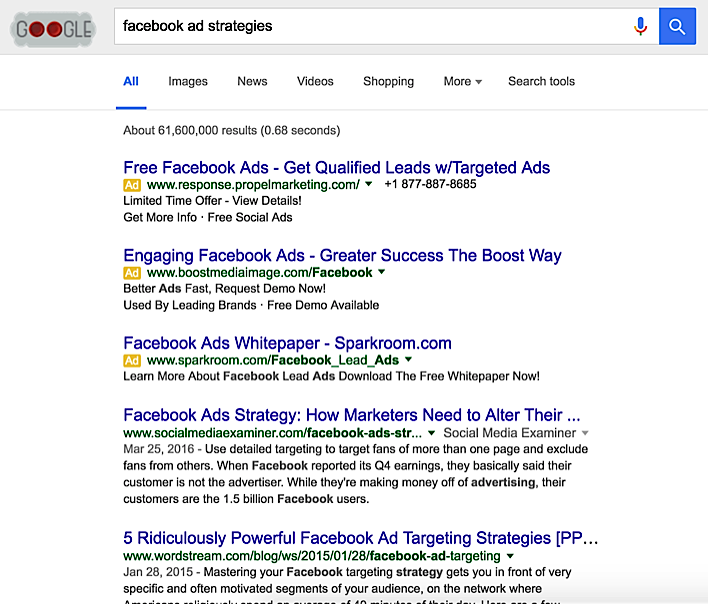
Or I could type a broad search term into a tool like BuzzSumo and immediately get a list of highly shared content related to my topic.
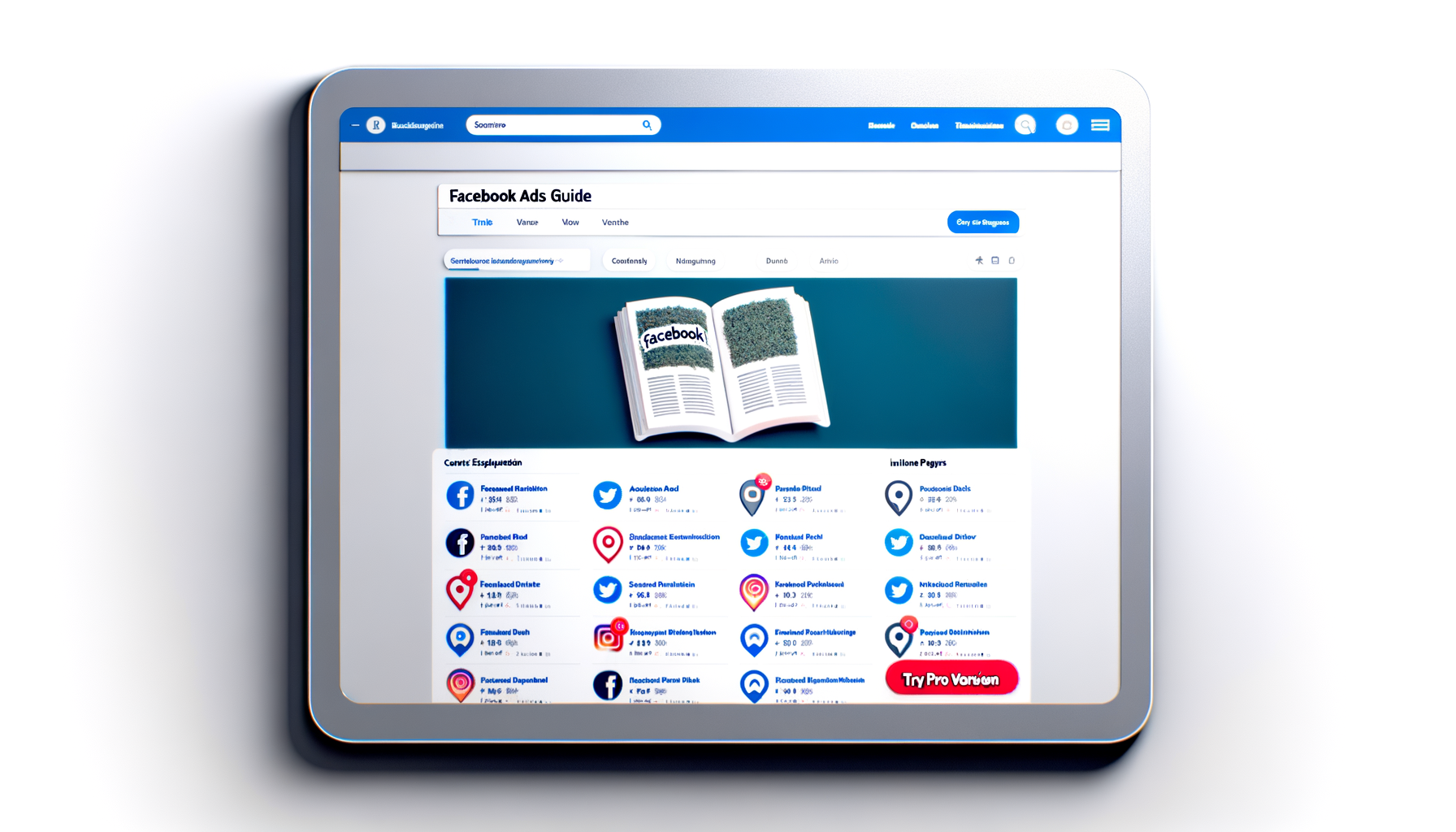
Next, I’d pick one of those successful pieces of content, and build on it.
One simple way to do this is just by making the post longer. For example, one of the top Google search results for “facebook ad strategies” is an article called “5 Ridiculously Powerful Ad Targeting Strategies.” To build on this idea, you might come up with something like “25 Facebook Ad Strategies to Grow Your Business.”
Another way to improve on existing content is by making it more visually appealing.
For example, this post on Pardot.com ranks at the top of Google for the search term “buyer journey,” mainly because of how the post is designed.
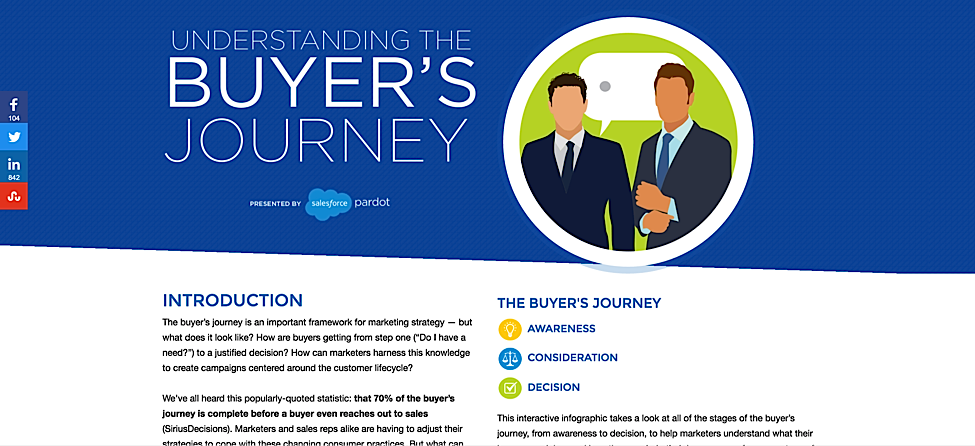
According to Brian Dean, by taking a post that is already proven and building on it, you drastically reduce the likelihood that your content falls flat because you’re writing content that has already worked.
An important factor for getting a post to rank high in the search results is having a lot of other influential people link back to it. One easy way to do this is by mentioning your industry’s influencers in your content.
When other people see their name mentioned somewhere on the Internet, they’re much more inclined to share the piece on their own social media, blogs or newsletters. And because industry influencers usually have large audiences, that means more targeted traffic back to your site.
For example, this entrepreneur curated an e-book full of the best Medium posts of 2015, and then sent it out to all the writers he mentioned within the e-book:
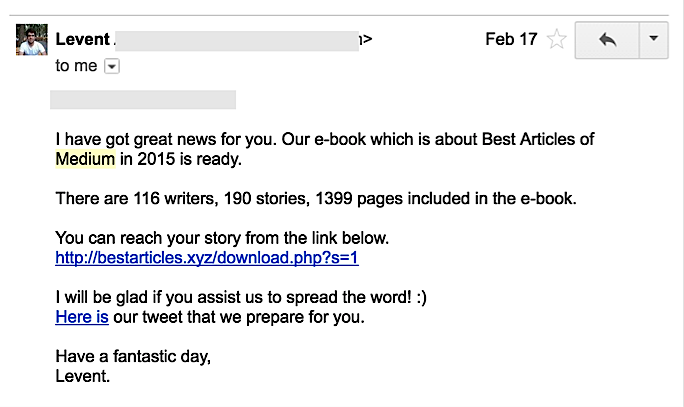
A simple e-mail like this sent to the right influencer could be the “tipping point” that makes your content go viral. In fact, according to Blogging Wizard, with the right approach you can get up to an 80% response rate from the top influencers in your industry.
We all have pages on our blog that perform really well in search, and others that fall on page three, four, or even lower. And the frustrating thing is that some of our low-ranked content may contain amazing material. If only those poor blog posts could get a little push — like a share from an influencer or several more backlinks — they might go viral or rank at the top of SERPs.
One way to give the poor-ranking content a push is by finding the posts on your site that rank higher in Google and adding links within them to the pages that rank lower.
For example, HubSpot ranks pretty high for the search term “content marketing strategy.”
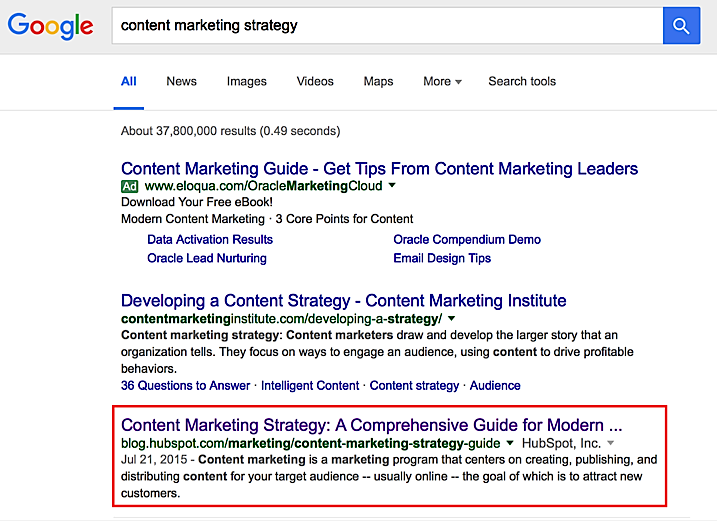
Within this post, they link to multiple articles on their blog about topics like list purchasing and developing a social media content calendar — neither of which rank as high.
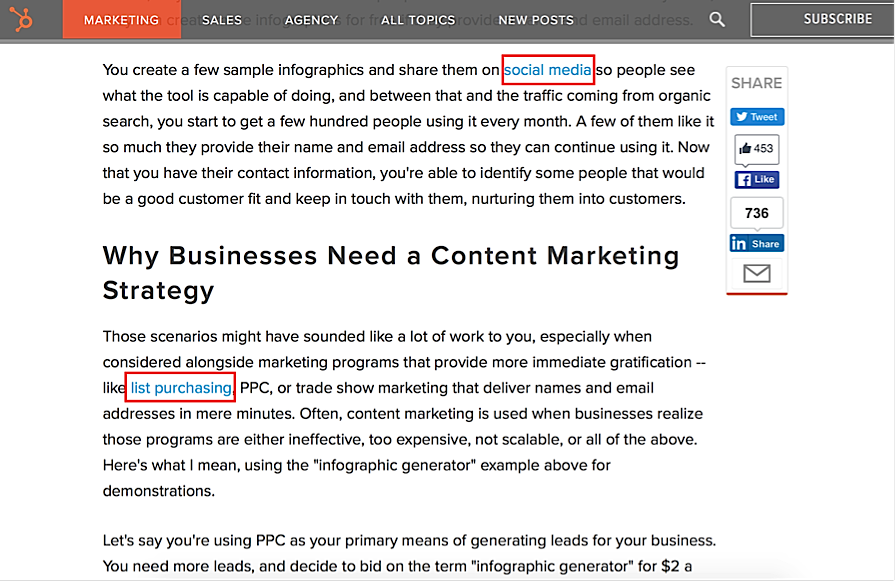
This is a great way to give some of your lower ranked content the boost they need to get to the top.
The best content is the kind that speaks to people’s emotions. Marketers who are able to connect with their audience can build a large audience of loyal readers relatively quickly.
Make sure you understand your market’s deepest hopes, fears and dreams around the subject about which you’re writing. Once you have a good grasp on this, you can weave it into your blog posts to show your audience that you really “get” them.
Steli Efti at Close.io, a SaaS product to help salespeople close more deals, does this really well.
Salespeople have a lot of hopes and fears around their job. For example, they might feel afraid of coming off as too “sleazy” or too fake.
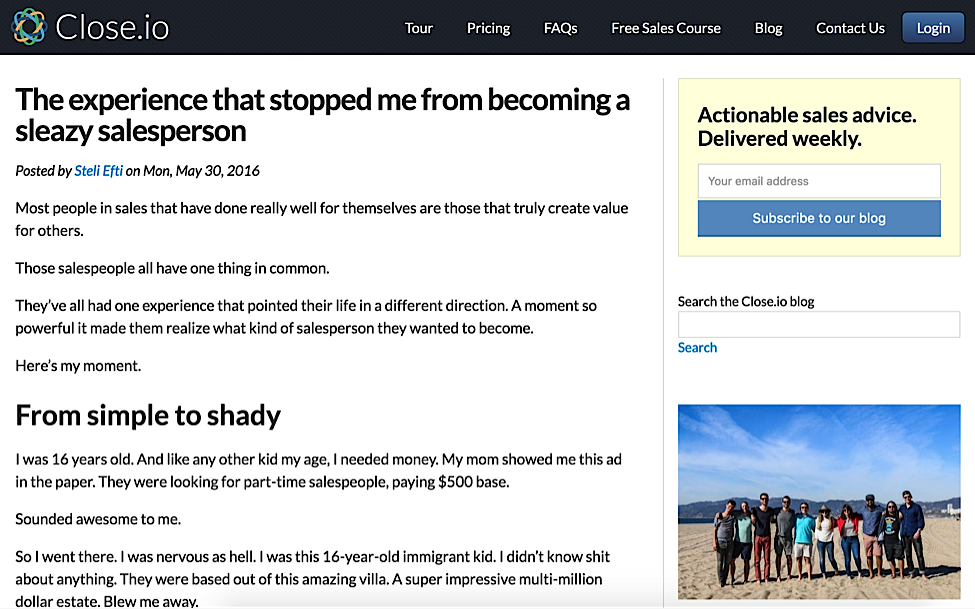
They might be afraid of hearing a bunch of “no” responses from leads.
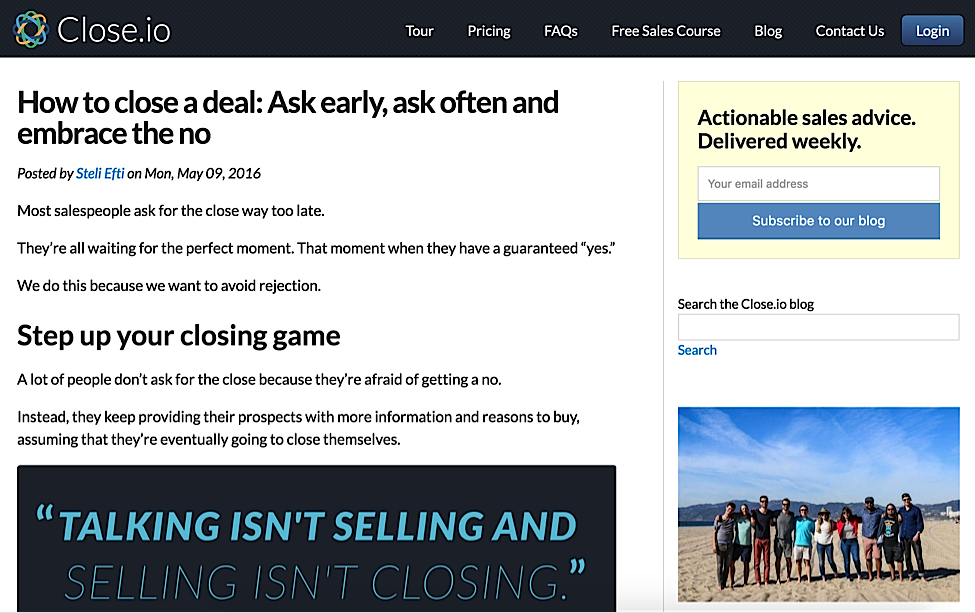
Or maybe they feel like they have no idea what they’re doing.
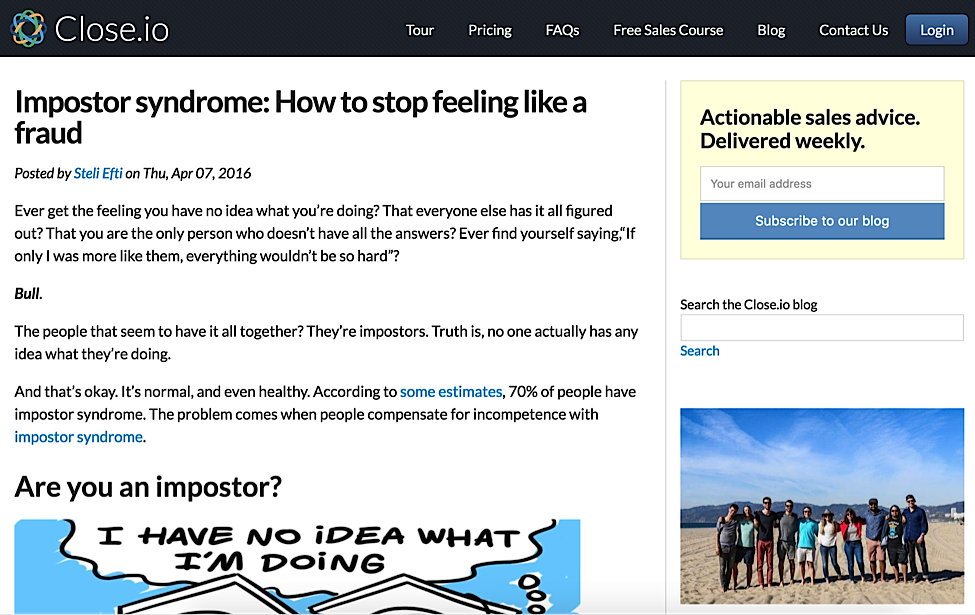
Because their content tells emotionally captivating stories that really “hit the spot” for their audience, Close.io’s blog has quickly become one of the go-to resources for salespeople.
Another great example is the Copy Hackers blog. Their content has a lot of personality infused into each post, which helps set the content apart from all the other marketing posts on the web.
Notice how friendly and fun this content sounds:
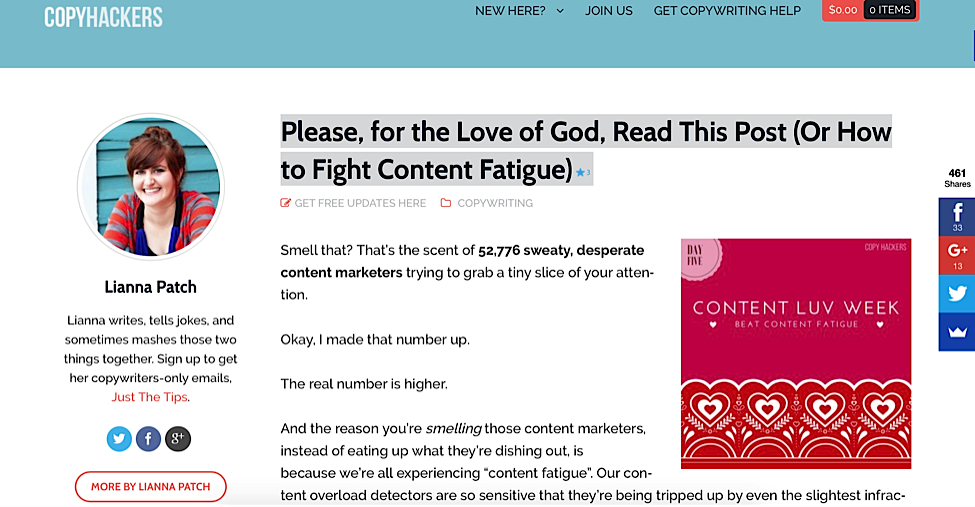
Businesses in virtually every industry can incorporate great storytelling and personality into their content if they understand their customers at a deep level. Even Pfizer was able to boost sales using this approach, according to this article by Cognitive Edge.
There are always a bunch of new SEO tactics popping up all the time, but at the end of the day, the best way to have your content reach more people is simply by writing stuff that they actually want to read! And one great way to do that is by writing posts that are fun and/or informative and appeal to the readers’ emotions.
Writing long-form content consistently takes a lot of effort. So before you start climbing that mountain, it’s important to ensure that you’re writing content for which people are actually searching.
One easy way to do this is by using the Keyword Planner on Google AdWords. It’s easy to see how many people are searching for a particular keyword, and you can even uncover related keywords to base your articles around.

Another great tool for gauging the number of search results for a particular topic is Google Trends, where you can uncover search trends over time for keywords to see if they’re worth pursuing.
Or you could use BuzzSumo to see the number of shares that certain types of content get and which keywords are getting a high rate of shares.
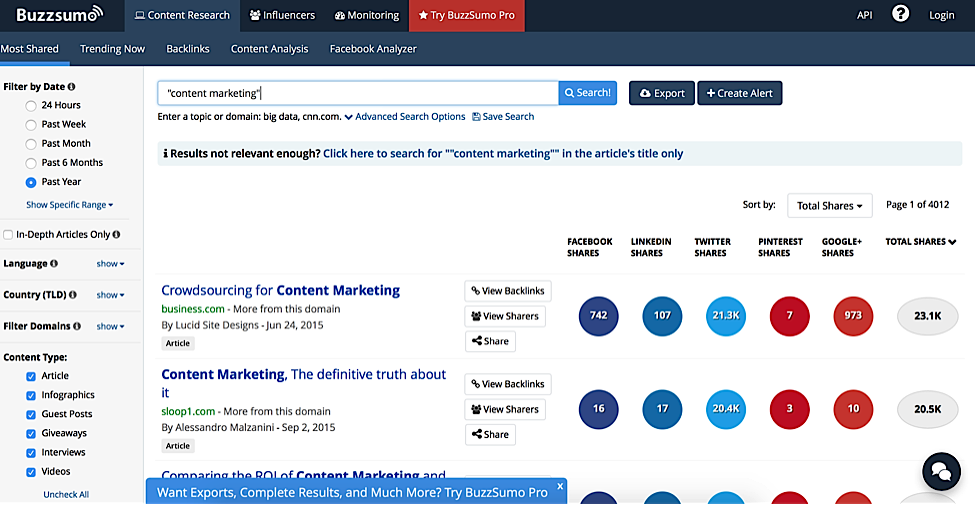
Moz has a great guide on how to do keyword research for SEO, including how to judge the value of a keyword and understanding how to use long tail keywords.
By creating remarkable, long-form content around keywords that have a high search volume, you make it easier for your blog posts to rank high for a topic and generate a lot of traffic to your website.
Broken link building is one of the most effective white hat strategies you can use to grow your SEO rankings.
The first step is to figure out which websites in your industry have broken links to your own site as well as your competitors’ sites. There are quite a few search term variations you can type into Google to uncover sites with dead links. According to this guide by Neil Patel and Brian Dean, here are some of them:
For example, you can type in “marketing + intitle:resources” to find posts that are filled with a bunch of links.
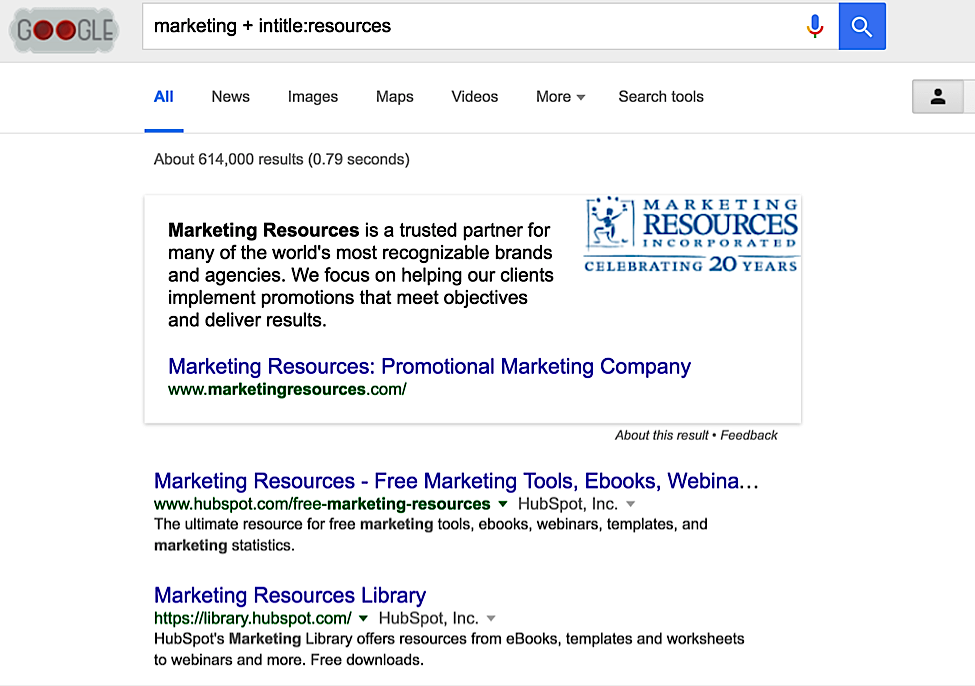
Next, you’ll have to scour the page to find the broken links. An easy way to do this is by downloading a Chrome plugin called Domain Hunter Plus, which scans pages for dead links.
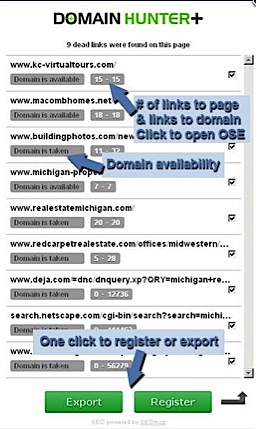
Once you activate the plugin for a particular page, you’ll get a list of dead links on that page. You can then export the list of links, send it to the site owner, and ask to replace the dead links with your own resources.
Relying on standalone blog posts to drive your SEO rankings is a losing battle.
A few individual pieces of content might appear high up on the search results, but there are better ways to get more mileage out of your blog posts. One tried-and-true way is the hub and spoke strategy.
Through this approach, you create one giant piece of content to function as the page that people land on directly from Google (your “hub”), and from that page, you link to a bunch of other relevant pages on your website (the “spokes”).
Your hub should be something that’s highly shareable, like a meaty post that people bookmark because of how informative it is and how many useful resources it contains. This way, your hub will rise in SEO rankings, and as a result your “spokes” will rise as well.
Copyblogger created a page called “Email Marketing: How to Push Send and Grow Your Business,” and within it, they’ve included supporting posts like “Why Vanity Metrics Are Worthless (and What Really Matters),” “37 Tips for Writing Emails that Get Opened, Read, and Clicked,” and more.
By creating a hub, or a “table of contents”-style guide around a topic in your niche that people can consistently refer to, you’re creating a larger piece of content that will rise higher and higher in search rankings.
And as a result, the content you link to within your hub will rise higher and higher as well.
As I mentioned earlier, mentioning industry influencers in your content is a great way to help your content get more shares.
And roundup posts are an efficient way to do this on a larger scale. In a roundup, you curate posts from experts in your niche and share them with your own readers. This tactic is an easy method to build relationships with the right people in your field, generate a bunch of traffic, and improve your SEO rankings.
According to Crazy Egg, these are a few key characteristics that make a high-quality roundup:
Once you’ve sourced a long list of high-quality links around a topic that your audience wants to know more about, you can ask each influencer to share the post with their own audience.
For example, here’s an e-mail that someone sent to me after including some of my content in a post:
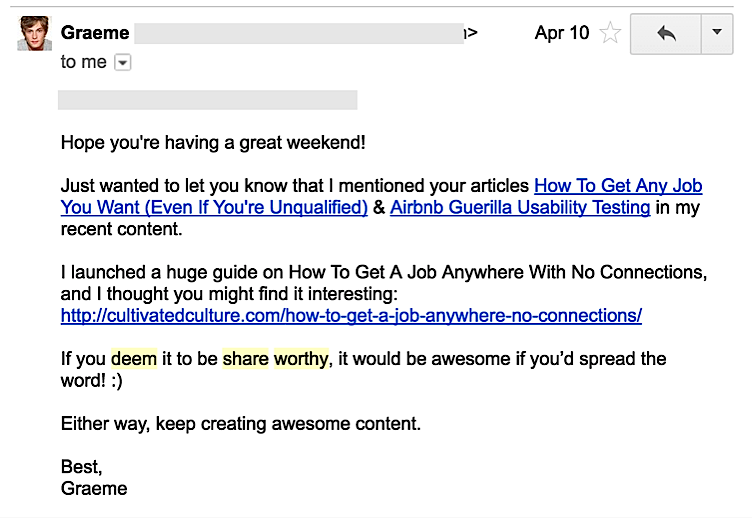
I ended up sharing it with my list of 20,000+ readers.
Long-tail keywords are keywords that are more specific and “narrow” than broader short tail keywords.
For example, “facebook advertising” is very broad search term, but “facebook advertising for SaaS companies” is much more specific.
It’s natural to create content focused on broad, short tail keywords. We think that because there are a lot of people searching for these more general phrases, we should take take advantage of that. But in reality, creating remarkable content that is focused on long-tail keywords can boost your conversions.
People want solutions that are tailored specifically for their situation. If you create a piece of content called “Facebook Advertising Strategies for B2B SaaS Companies,” you’d make B2B companies feel that you understand their specific situation a lot better than someone who wrote an article called “25 Facebook Ad Strategies to Grow Your Business.”
Even though you would be going after a smaller pie, you would dominate a much larger piece of it.
For more on how to identify and leverage long-tail keywords for SEO, see this guide: How to Identify Long Tail Keywords for Your SEO Campaign.
Whatever strategy you’re pursuing — whether it’s Facebook ads, SEO or anything else — the main point is to drive more prospects along the buyer’s journey to becoming customers.
That’s the main goal of content marketing.
SEO works best when it’s part of that larger content marketing strategy.
According to this guide by Salesforce Pardot (and this image from HubSpot), customers go through the following three stages before deciding to buy:
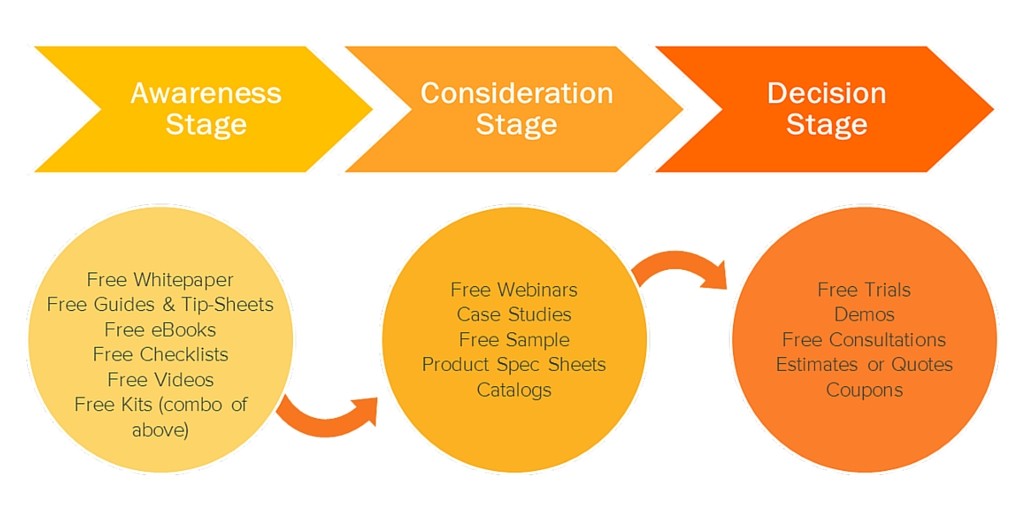
By creating high-quality content to serve customers at each step of the process, you’ll naturally rank higher in search results while also generating more sales.
Awareness Stage
At the awareness stage, customers are usually conscious that they have a problem, but they have no idea what the right solution looks like.
For example, if you’re selling services to help CEOs improve their content marketing, they might be thinking things like: “Ugh, I don’t want to waste hours and hours writing blog posts if I have no idea what the payoff is going to be” or “I need to outsource this but I don’t know how to figure out who’s the right person to handle it.”
At this stage, 72% of people immediately turn to Google to figure out how to solve their problems. They search for content that hits their specific pain points.
If you’re selling marketing services, a good piece of content to write might be something like “How to Speed Up Your Content Marketing Success.” This way, when customers search for their problem, your blog will be the first one they see.
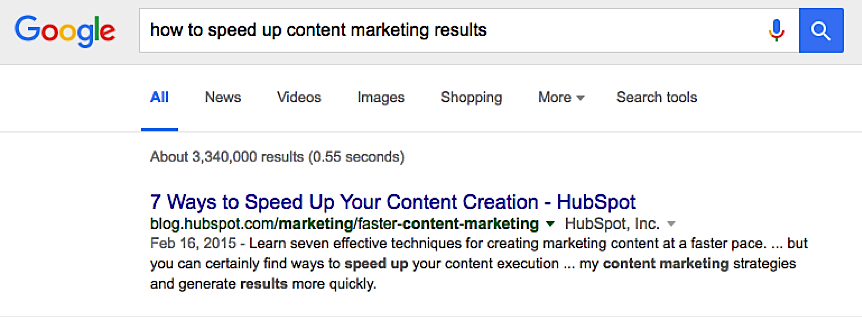
An example of how HubSpot attracts customers who are in the “awareness” stage.
Interest or Consideration Stage
As potential customers start to gather more information about their problem, they look for ways to solve it in the “interest” phase. At this stage, evidence-based content starts to become a lot more valuable to them.
According to Crystal Clear Communications, 30% of buyers consult white papers at this stage of the process, 29% consult case studies, and 30% of buyer influencers look to detailed technology guides.
Again, if you’re selling marketing services, good content at this stage might sound something like “The Ultimate Guide to Getting More Leads Through SEO.”
You can present these guides at the bottom of your blog posts and ask readers to fill out their e-mail address in order to receive them. This way, you help people transition from the “awareness” phase to the “interest” phase, and you capture their e-mail addresses so that you can send them more content down the road.
HubSpot does this well — when customers start off in the awareness phase searching for something like “how to speed up content marketing results,” HubSpot’s blog post is the first thing they see on Google:
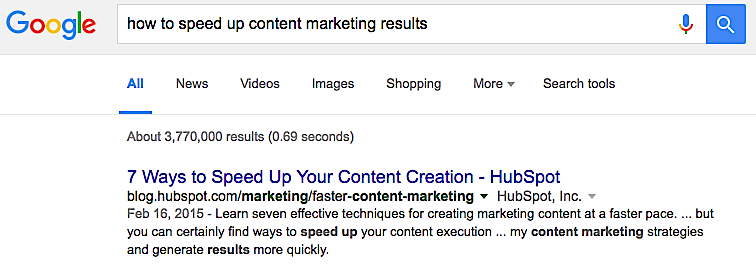
And at the bottom of that post, site visitors can sign up to get a free content strategy planning guide.
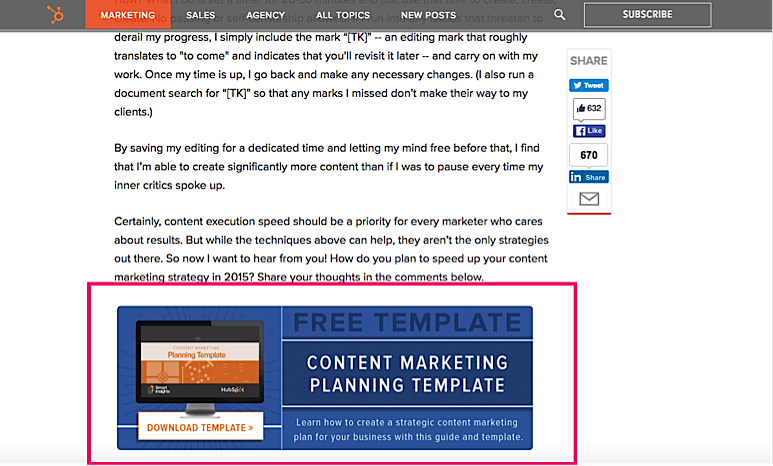
Evaluation or Decision Stage
Only after customers have done their research and figured out how to go about solving their problem are they ready to start thinking about purchase options in the “evaluation” phase.
At this stage, they’re trying to decide which service to buy. Good content here might be something like “4 Steps to Picking a Good Marketing Agency,” “Why Some Marketing Agencies Don’t Get Good Results” or something else along those lines. And in these posts, you can strategically position yourself against your competition by “teaching” your audience why you’re better.
Understanding what your customers are searching for at each step of the journey is super important — that way, you can create highly ranked content to help them along the way.
There are a few specific metrics that you can track to measure your overall SEO performance.
For example, one key metric for SEO is the average time that users spend on your content page. If your content is engaging, if it appeals to their emotions, if it’s useful, then readers will stay on the page longer in order to read more of your material. For more on the right metrics to track for your SEO, check out this post by Neil Patel: Quantify Your Results: The 14 Most Important Content Marketing Metrics.
If your website does not provide quality content, visitors will “bounce” off the page and “boomerang” to a competitor’s site.
Keep in mind that there’s no specific number here that can be considered “good” or “bad.” If you’re writing short-form content, for example, then you’re naturally going to have a low average time on your site. Or if you offer a great answer to a reader’s question, you might have a high bounce rate but also a high time on your site.
The number of return visitors is also a good metric to gauge how good your content is. How many readers come back to your site on a regular basis? If you’re sending e-mails to your subscription list regularly, how many people consistently open and click?
This is one of the most useful metrics that you can measure since return visitors are usually the most likely to convert to buyers.
There are a lot of benefits you can get from associating yourself with experts in your industry.
Read More: 5 Steps to Becoming an Expert Content Creator (According to Google’s Phantom Update)
One of the best ways to leverage that association is by interviewing these experts and repurposing the content into a blog post. That way, you can rank high for the expert’s name and siphon off a large audience that searches for them.
For example, Groove did an interview with Neil Patel and repurposed it into a blog post. Now when anyone searches “Neil Patel interview,” Groove shows up at the top of the results.

Venture Hacks did an interview with Sean Ellis, which also ranks at the top of Google for “sean ellis interview.”

By interviewing influencers in your industry and turning it into a blog post, you can attract a chunk of that influencer’s audience to your own site through Google search.
Part of maximizing the effectiveness of your content marketing is repurposing your material as much as you can.
As Neil Patel and Aaron Agius write in QuickSprout’s Complete Guide to Building Your Blog Audience, there are at least seven different ways to repurpose a single blog post. Turn it into a:
This could skyrocket the reach of each post that you write.
Let’s say you published a blog post called “How to Leverage Influencers in Your Content Marketing.” There are tons of different formats into which you can repurpose this content to attract a wider audience.
For starters, you could take that content and make it native for different blogging platforms like Quora, Medium or LinkedIn — which allow anyone to reach a targeted audience of tens of thousands of people if the content is good.
Then, using a tool like Visme, you can take that blog post and turn it into infographic.
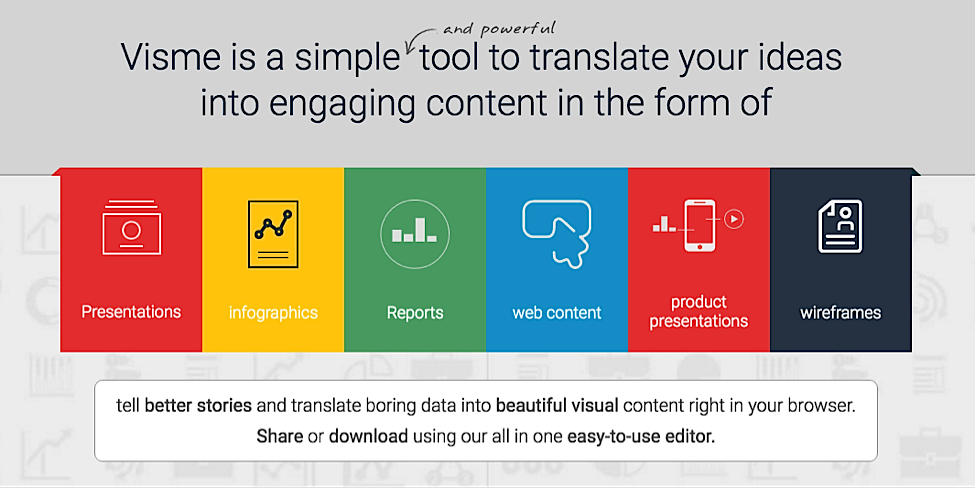
Noah Kagan found from analyzing 100 million articles that infographics get shared the most out of all types of content. This means that an infographic could potentially get more than double the reach of a single blog post, which makes it more likely to rank higher in search.

Then you could take the blog post and infographic and combine them into a compelling SlideShare presentation.
If you have a podcast, you could summarize the key points of the blog post in a quick 10-minute audio segment.
With a simple, structured system, you could skyrocket the reach of each piece of content you put out by making it “native” to several other platforms simultaneously, thereby increasing the likelihood that the content will rank high in SERPs.
A simple way to get more reach on your content is just to increase its length.
Longer-form posts are more comprehensive, get shared more frequently, and lead to lower bounce rates — which is why they tend to be ranked higher on Google.
According to serpIQ, average length of posts at the top positions on Google are 2450+ words.

Not only does this help with SEO, but more time spent on your page means you’d be cultivating more trust between you and your audience.
Content that’s visually appealing allows readers to digest a larger amount of information in a shorter period of time. It’s much easier to look at a graph or an infographic that’s well designed than a huge 5,000-word blog post — and as a result, it’s more likely to get shared.
You don’t need to be a design whiz to create content that’s visually appealing either. You could use a tool like Snapguide to create beautiful how-to guides, for example.
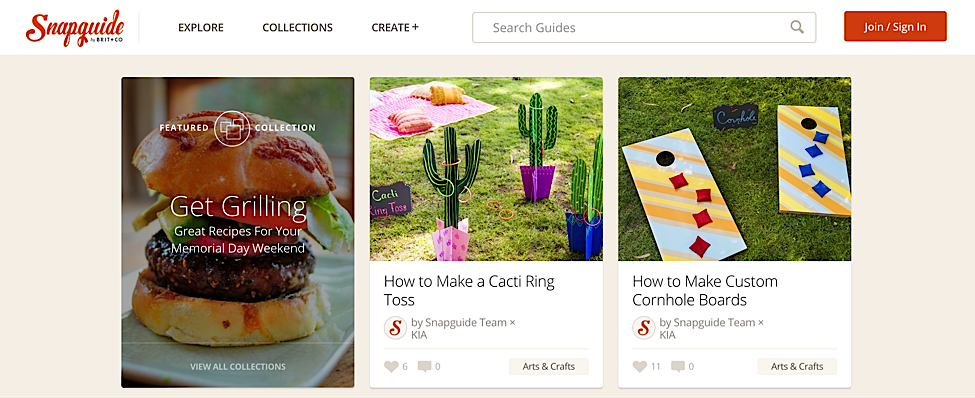
Written content is still very important, but the way the content is presented is also important. The more visual, the better.
According to Commonplaces Interactive, both Google and Bing have reported higher search traffic coming from mobile devices than computers.
That’s why these search engines boost content in search rankings that are mobile friendly.
If you’re not sure whether your site is mobile friendly or not, you can just insert the URL into Google’s Mobile Friendly site analyzer.
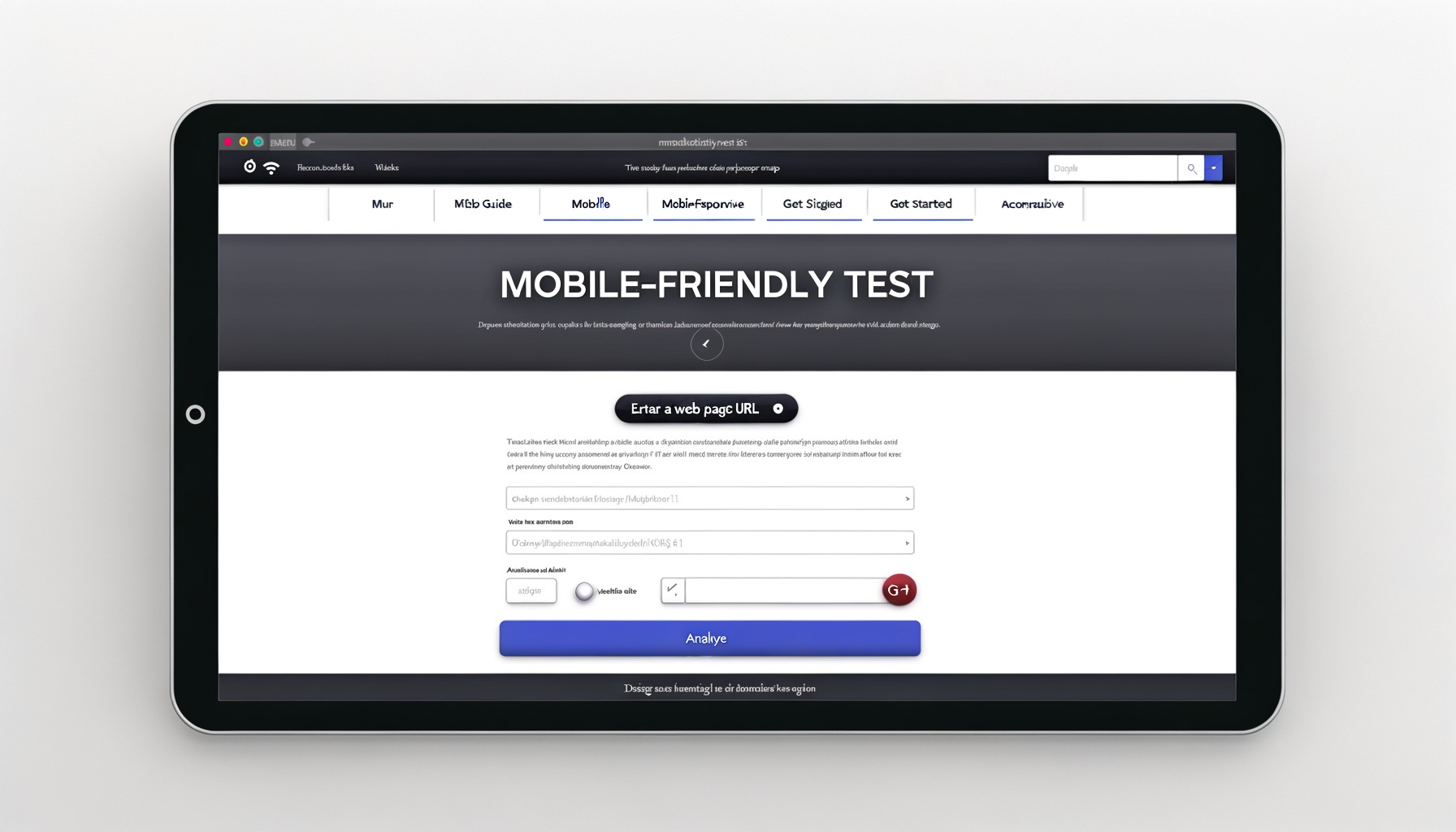
The easiest way to make sure that your site doesn’t get penalized in search results for this is by making it responsive. That way, it will “respond” to the device on which it’s being viewed, and won’t encounter any problems on any mobile devices.
By writing original blog posts on major media outlets, you can get a lot more exposure to your own site.
For example, Neil Patel wrote a guest post on Entrepreneur.com.
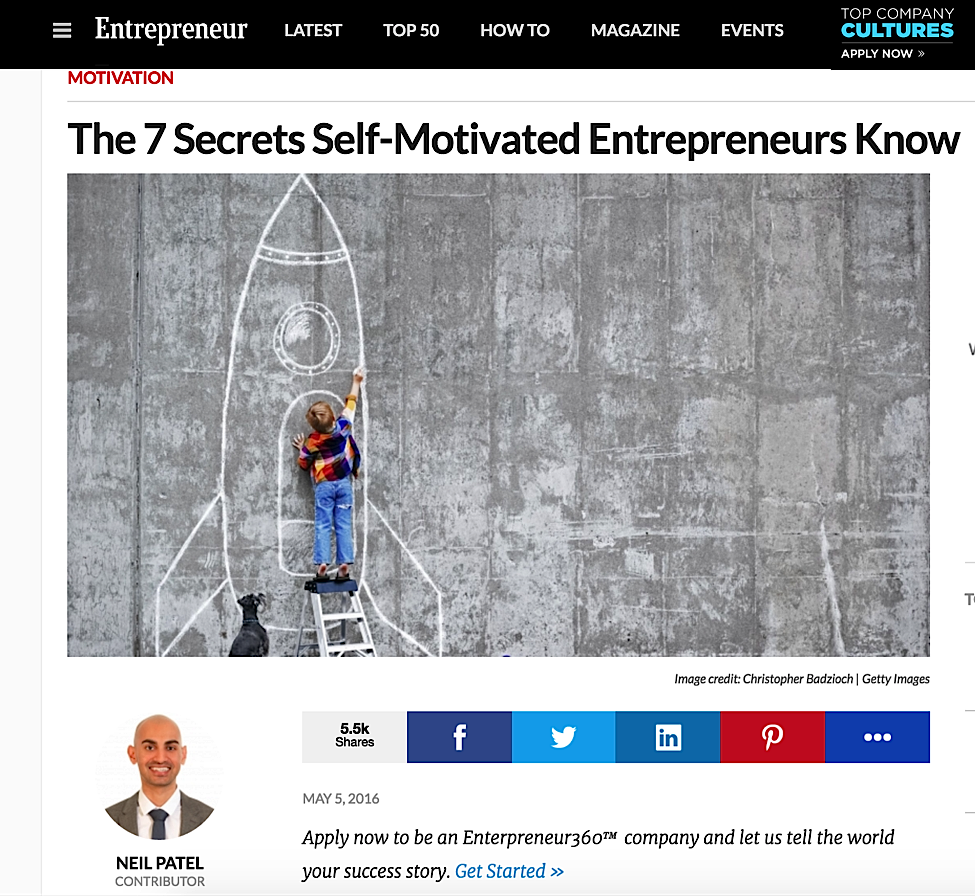
Within the post, he included multiple links back to his own blog, Quicksprout.
One thing you might want to be wary of is reposting content from your blog to a major media outlet. Although the exposure would be good, Google penalizes duplicate content in search results.
But writing original content for major sites could help build your credibility as well as get more backlinks to your blog. For more on this, check out How to Pitch a Guest Post to Editors at 104 Major Publications by Jon Morrow.
Another quick way to get more backlinks for your blog is by using a service called Help a Reporter Out (HARO). This site is aimed at the tons of journalists out there who are writing stories on various topics and need quotes from experts.
When you sign up for HARO, you’ll get notified every time a journalist who is writing about a topic in your field needs a quote. Then you can send in a quick pitch offering a quote along with your business name and website URL.
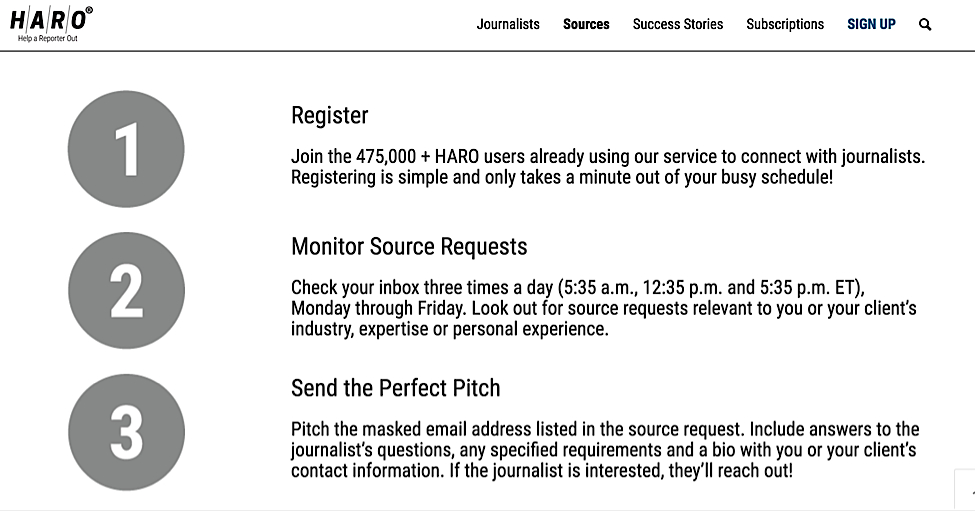
This is a great way to get your name and blog on a news media site without having to write a unique guest post.
If you deeply understand your audience’s emotional experience at each stage of the buyer’s journey, you can consistently create high-quality content that not only sits at the top of Google’s SERP, but also drives sales.
The best part is that it’s actually really easy to understand your audience’s emotional pain points.
All you have to do is set up an autoresponder message for everyone who signs up for your e-mail list. As soon as someone subscribes, you can send them something like this:
Hey [name],
I get hundreds of “marketing” e-mails everyday from random companies that are just a pain to sort through.
I want to be different. I want to send you e-mails that you actually look forward to reading.
So to make sure that I send you the best possible content, I wanted to ask you a quick question… What’s the #1 barrier that’s keeping you from [whatever success you’re trying to help them achieve]?
Just “hit reply” to this e-mail and let me know. I read every response.
Thank you,
[your name]
You’d be surprised at how many people pour out their life story in response to that, which helps you to know exactly what’s going through their mind.
It’s even better if you ask for feedback at each stage of the customer journey. Derek Halpern of Social Triggers asks non-buyers for feedback right after they make the decision not to buy from him:
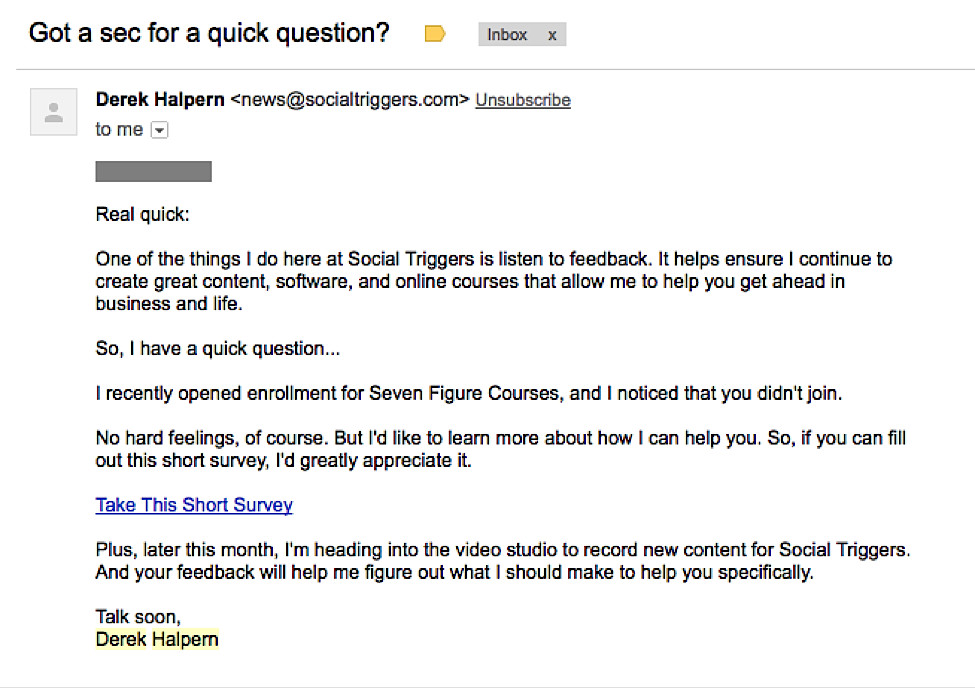
This way, you’ll know exactly how to create the right type of content that resonates at a deep level with your readers, gets shared, and ends up ranking high in the search pages.
This isn’t easy to do, but if you can do it, you’ll skyrocket the reach of your blog. People who invent terminology that catches on in their industry can really boost their SEO rankings.
For example, Brian Dean of Backlinko invented what he calls the Skyscraper Technique, which is a unique approach to creating content.
Now when anyone searches “skyscraper technique” on Google, his name is all over the web on multiple different sites.
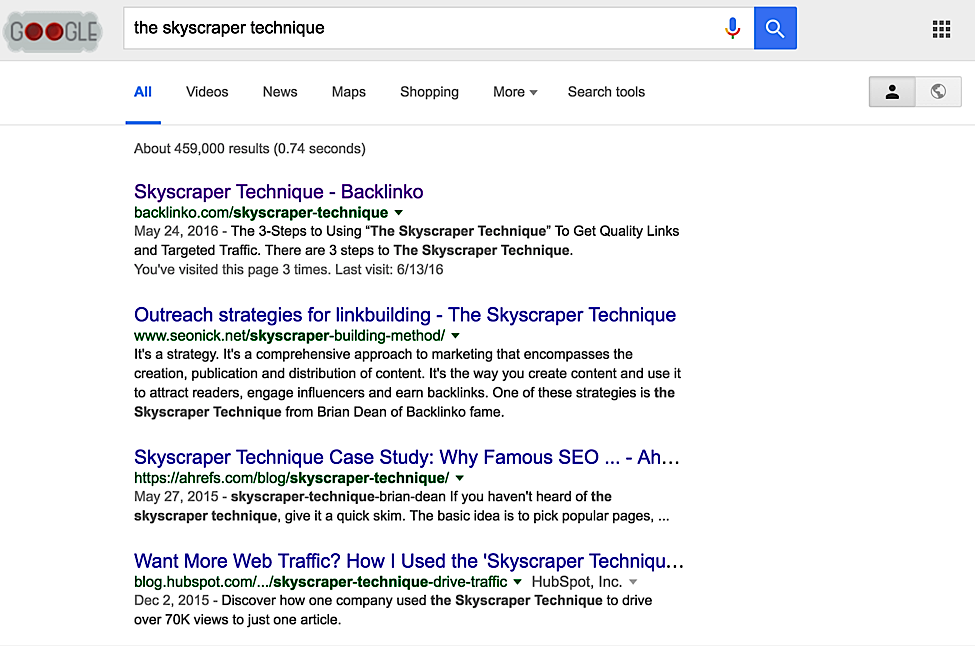
To invent your own term, you don’t need to create some crazy new breakthrough idea in your industry. All you need to do is take existing points of view that are already out there, “repackage” them, and make them your own.
For example, Tim Ferriss wasn’t the first ever lifestyle design blogger, but he was the first to package up his ideas into the “Four Hour Work Week.”
Gary Vaynerchuk isn’t the first to talk about understanding the context of social media platforms, but he was the first to position as “Jab Jab Jab Right Hook.”
So there you have it — 20 ways to boost your SEO rankings!
As marketers, there are a lot of tactics out there that we could potentially focus on. But those who get world-class results get them by focusing on high-leverage activities that deliver real long term results.
Now I want to hear from you. What other SEO tips would you recommend? Leave a comment below!

This post originally appeared on Single Grain, a growth marketing agency focused on scaling customer acquisition.
Snapchat, the instant-photo sharing site, connects people through the picture-based stories that unfold on their mobile devices. Lately, Snapchat has evolved from a teenage phenomenon to a social media platform with great reach into the young adult demographic. With daily video views increasing 400 % last year, from 2 billion to 10 billion, the site’s reach is growing exponentially.

Like any social media site, your company’s potential reach depends on the connections you make through the site. In the case of Snapchat, that means your friend list.
Now, all of us have friends (at least, I hope you do!). But I’m not talking about getting your buddies onto Snapchat, although that’s fine. I’m talking about making connections with others — some you know and some you’ve never met in person — via Snapchat apps that can help you find others with similar likes. That includes customers, potential customers, and anyone else who might want to do business with your brand.
Although Snapchat makes it a little trickier to connect with others on their site, it’s still possible to gain followers. The following methods, techniques and tools will help you add more Snapchat friends to your connections. And the more connections you have, the more likely it is that your content goes viral. If (or should I say ‘when’?) it does, you’ll reach even more potential viewers.
If you’re new to the site, get to know its strengths and weakness, quirks and surprises before rushing to add connections. You need to have a strong Snapchat presence before sharing with others, or else you’ll waste your initial efforts building your friend list.
Open Snapchat’s app on your smartphone and connect it to your iPhone or Android’s contact book. The site will ask your permission before proceeding to connect you with any friends who are already on Snapchat.
You can’t sync Facebook and Snapchat directly, but you can move your Facebook data to another place and then move it into Snapchat.
Download friend info from Facebook into your phone, then use the Snapchat icon to connect friends from your phone’s contacts to Snapchat. Basically, you’re using your phone’s contact book as an intermediary for holding friend data before moving it into Snapchat.
Read More: Facebook Lead Ads – Everything You Need to Know to Increase Mobile Conversions
If you open the Snapchat app on your camera, go to the screen where you take a picture. At the top is the Snapchat icon and clicking the icon will take you to another screen that enables you to add the white or yellow ghost to a colored box. This image differs for every user, so you can think of it as your unique fingerprint on the site.
Share this image on your website, Facebook profile or wherever else you share pictures. If others hover their phones over it, they can connect with you via Snapchat. It’s like your own personal shortcut.
 5. Share your icon in person
5. Share your icon in personYou can also share your Snapchat icon in person. Just hold out your phone and have others swipe the image with their camera. They’ll connect directly to you via Snapchat.
iTunes offers a free Snapchat friend app called Snap Usernames that lets you search for friends on the site. AddMe is another app that lets you add both Kik and Snapchat friends. These apps make it easy to find new connections on the sites.
Many Instagram users are also on Snapchat, so it’s a good idea to create Instagram teasers that encourage people to follow you on Snapchat. You can also add your Snapchat name to your Instagram bio. A direct link will make it easy for people to connect with you on both sites.
Unique deals and incentives that are offered only through Snapchat and are unavailable on other platforms is a good way to generate some buzz and interest. Keeping it exclusive encourages people to sign up and follow you on the site.
You’ve got to have unique, interesting and creative images and video to get people interested in your Snapchat presence. If you just share the same old boring stuff, Snapchatters won’t follow you, and your content won’t get passed along. If you’re not worth following, you won’t be followed on Snapchat, period. Make it worth people’s time and effort to follow your content!
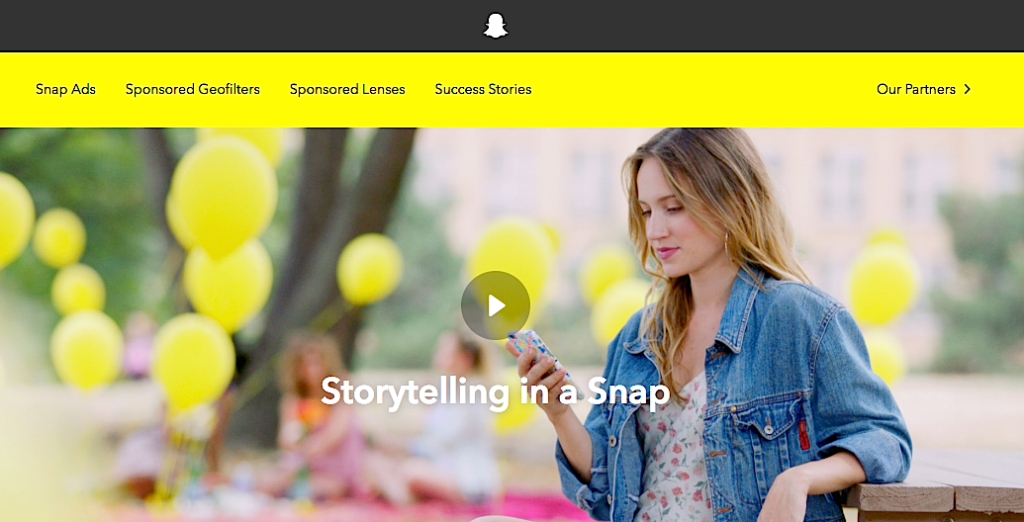
Snapchat automatically assigns “best friends” based on the people you connect with the most frequently. The site sets the limit at 3, 5 or 7. Set it for the maximum to see the most people and develop friendships with their friends, too.
Let’s say you’ve used all these tips and connected with tons of people. Great! Like anything else, you’ve got to build on relationships in order for them to last. That means learning how to be a good Snapchat friend.
For starters, remember: friends don’t let friends do these things on Snapchat….
If, despite your best efforts, you end up with some unsavory characters who send you random videos and you want to block them from Snapchat, you can do it from the app.
Open the Snapchat app, click the gear icon, and find the name of the person annoying you. You can then choose either Block or Delete to keep control over your friend feed.
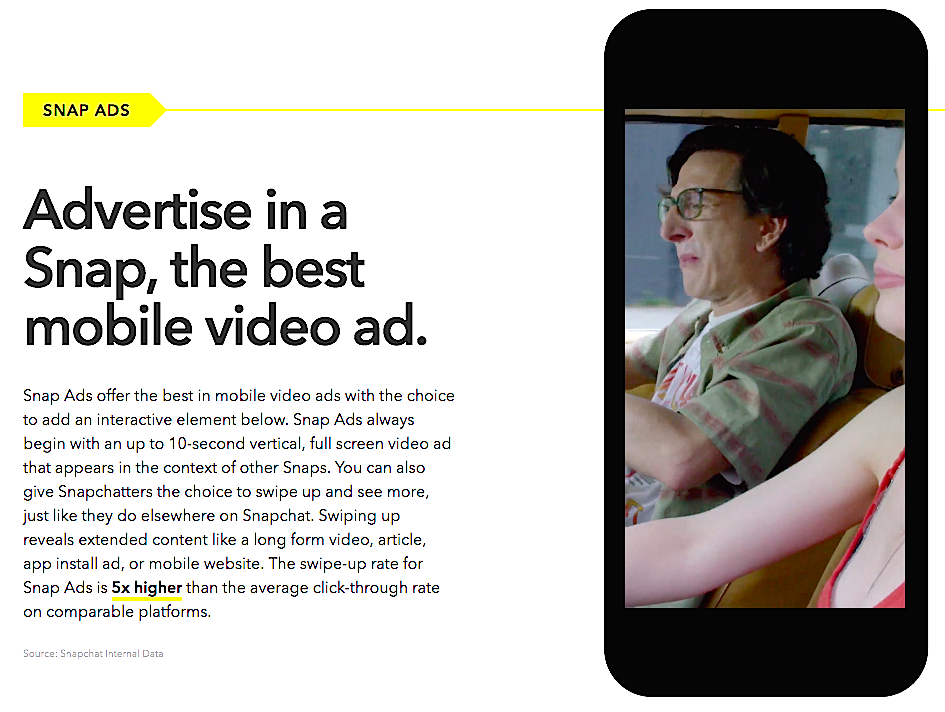
Snapchat spent four years refining its site, and now it’s time to make money. Though the feature hasn’t been released yet, the social media site plans to show ads between friend’s stories on the app. Advertisers will be able to choose the actions that users take when they see their ads, and Snapchat users will see ads on the site.
Read More: How To Drive ROI Using Gmail Sponsored Promotions (GSP)
Snapchat Partners, or companies who advertise on Snapchat, will also benefit from a new app that makes it easier to run and manage Snapchat ad campaigns on the site. The company has also added new partners to help advertisers measure their ad campaign’s success and progress towards goals, two very grown-up tasks for a site that caters to high school and college kids.
With Snapchat snapping at the heels of rival Instagram, finding new Snapchat friends is an important task for anyone serious about using the site for marketing purposes. If your customer base includes young adults and Millennials, finding and making new Snapchat friends, using the site in a way they like, and leveraging advertising are all part of the total package that will make you a Snapchat superstar.
What other tips would you add to this list when it comes to making new Snapchat friends? Leave me your suggestions by dropping a comment below:
Images: Snapchat, usdemocrazy

I want to talk about content repurposing.
Right now I’m writing a book called Leveling Up. It’s about how gamers can change the world by playing the ultimate game of business. It’s basically what I think I’m doing right now.
The backstory: I used to play a lot of games growing up, because I was never really interested in school. So I did what I could with games and strived to be the best at whatever I could play. I knew that if I put some effort into it, I could be good at it.
That’s why I’m writing this book—because there are 1.8 billion gamers (spending $22 billion in one year!) out there who could be changing the world, if they just knew how.

(Source)
A lot of the stuff that I learned from games, a lot of the soft skills, actually translate extremely well into the world of business. For example, you can play your best poker for months at a time, but it’s a numbers game at the end of the day and sometimes there’s going to be variance. When you’re losing for a couple months, you’re really going to get rattled. As a result, you have to learn how to control your emotions better.
In the course of writing Leveling Up, I found a format for real-life case studies that works well. I’ll lead with a topical quote, then go into a personal anecdote and finally give some real-life business examples, too. For example, in one chapter, I might start with gaming but end up talking about Steve Jobs or Elon Musk.
And that’s when it hit me.
I have all this other content. I’ve interviewed over 200 entrepreneurs on my podcast Growth Everywhere at this point. Why not include these people, too? I don’t need to reinvent the wheel. All these success stories (and failures) are evergreen and incredibly valuable. That’s an example of repurposing content.

So I’m working on the book proposal to take to a publisher, which is basically an outline that includes a snippet of each chapter. From there you have to write a marketing plan, too. They want to know how you’re going to market this thing. That could be a whole other post or live video.
There’s a really good article from Seth Godin called ‘Advice for Authors‘ which is basically a 19-point list on what to expect as a writer as you try to get your book out there. If you’re looking to make a lot of money by writing a book, you probably shouldn’t be doing it, because that’s pretty rare. Harry Potter is a great example of perseverance. Anyway, I digress.

What I’m doing now is adding content from my Growth Everywhere interviews. Usually when you write a book, you probably go through four or five drafts at the minimum. The first draft that I did was really a lot of dictating into my phone and then transcribing it, and then getting it onto paper. Once I have it all transcribed, all I need to do is continually rewrite something until it’s more to my liking. That’s a kind of repurposing, too, because I’m constantly iterating it.
Let’s say I’m talking about sustained learning. From there I’m going to look for somebody that I remember as a learner who’s really driven. All these people in the podcasts are really driven, but who really stands out to me? In this example, Emerson Spartz (listen to his interview here) dropped out of middle school and his father made him read biographies all the time. The web properties that he has drives over 160 million monthly paid views. He’s really motivated.
Another example is from Ron Klein (listen to his interview here). He’s the guy that invented the magnetic credit card strike. I’m going to put him in another chapter about perseverance because he was diagnosed with a disease when he was 16 or so.
I also have a topic section. There’s one on A/B testing. Who are all the people that I’ve interviewed on A/B testing? Who are all the people that I’ve interviewed on advertising? Guess what? I can make mini podcast episodes for each and every one of these topics and just keep adding to them. I don’t need to reinvent the wheel. I can just repurpose the content I’ve already got.
Read More: 5 Important Landing Page Elements You Should Be A/B Testing
Not only that, but I have my other podcast called Marketing School and I can categorize every single idea in there and repurpose it into a post or a separate podcast or live video. A lot of this stuff, these stories, they’re never going to fade. They’re evergreen.

Think about all the content that you’ve produced. How are you going to make it evergreen? If you aren’t producing content yet you should be! For us, it is the backbone of what we do. Without me doing my podcast it wouldn’t have led to speaking gigs and I wouldn’t have spoken to Joe Pulizzi of Content Marketing Institute who said, “Hey, you have to do the book,” which is why I’m doing the book right now.
The more you learn, the more you’re able to speak to things, then you can start to put content out there. You realize that the people who do try to create content when they don’t have much experience, when they haven’t paid their dues, you’re going to find that their content falls flat and they eventually give up.
Can you turn your content into videos? Can you make it into another podcast? Can you put it into your book, for example? What can you do with it?
Let me know what you think. Let me know what issues you see with this. Leave some messages in the comments.
This post was adapted from Eric’s Facebook Live videos: Growth 90 – DAILY live broadcasts with Eric Siu on marketing and entrepreneurship. Watch the video version of this post:

I’m going to show you the growth of the two podcasts I’ve had over the last three years or so. This growth lesson basically applies across the board to whatever you’re trying to do. It doesn’t even have to be business related. It could be life related.
This is my first podcast, Growth Everywhere.

For Growth Everywhere, I was able to grow it from 0, no audience at all, and now we’re getting about close to 80,000 downloads a month. But it a was a long road there. I basically started in November of 2013 and I was getting about 10 downloads a day.
So, the thing is, I spent a lot of time on this in the beginning. I had to put myself out there, do all these interviews, and reach out to people, which was pretty nerve wracking. At the time, I just came into Single Grain, too, which is the digital marketing agency I now run.
Learn More: How to Choose the Best Digital Marketing Agency
So there was a lot going on, and I decided to start this at the same time just because I thought I could give back and help the community. And I really wanted to talk with these smart people, ask them how they grew their businesses, so I could provide value to everybody else, too. I knew I could do “deep-dive” interviews with entrepreneurs, and really dig into how they were able to grow their businesses, and what their funnels looked like, and try to draw out these growth lessons, both business and personal.
A year later, November 2014, we went from about 10 downloads a day to about a 172 (or 300 downloads a month to 4,500-5,000 downloads a month), which is not too shabby. That’s a 17X daily increase. I was putting a lot of time into it, so I knew that I probably needed to delegate this, but I still kept continuing on. I was basically doing one interview per week.
I also added in short little segments called Growth Bites (screenshot of some episodes below) where I’ll talk for 5-10 minutes. Much like what I’m doing now with my Growth 90: Daily Live Broadcasts, but this is live, and this is going live to both YouTube and Facebook at the same time. Hopefully, we can go live to Instagram and Twitter soon, too.
Now, jump ahead to 2015. We went from about 170 downloads in a day to about 327 a day. So, 10, 172, 327. The growth is still not that crazy. It took basically two years to get to about 9,000 downloads a month. Which is not too shabby, but just shows that it takes a lot of time. Just remember, when you invest in your business’ growth, it takes a long to time get there, but often times we expect to get there a lot faster. It’s just not the case.
If we fast forward another year to 2016, then we’re getting about 1,900 a day (about 60,000 a month), and you can see we’re still growing. It took three years to get to 80,000 downloads a month.
Just keep in mind, we have to put things in perspective here: Podcasts only have an audience of about 52 million people. Which is much smaller than the Facebooks of the world, and much smaller than the Snapchats of the world too. So, just keep that in mind.
Podcast listeners are growing, though. According to this Edison graph from Convince & Convert, 21% of Americans listened to podcasts in 2016, and if you go back one year it was about 17%:

Key lesson here is that growth takes time.
Doing this podcast basically led to my next podcast with Neil Patel, called Marketing School. I interviewed a lot of different people, but I wanted to nerd out on marketing, too, because it holds me accountable. So Neil and I started Marketing School in August of 2016, and right out of the gate we were getting about 4,000 downloads in a day.

The reason for that was that I had already built a small audience, Neil had a huge audience because he’s been doing it for a very long time, and together we were able to grow it from 4,000 downloads a day to anywhere from 12,000-26,000 a day (about a half million downloads per month).
We have some spikes here and there, but if you want one podcast tip, it would be to show all your episodes at once instead of just showing 100 (by default, iTunes caps you at a 100). Show everything, so that more people can discover your stuff. I’ve had people who will search iTunes and say, “Hey, is this you?” They literally found my podcast that way. I’ve had people stop me in the elevator, asking if I was that guy from one of the podcasts, too.
That part’s great, but the best thing about doing all of this, or building an audience anywhere, is the e-mails you get from people saying, “Hey, I was able to find my first job. I had no degree, and this podcast basically helped me get my first marketing job.” Somebody else was like, “Hey, my partner and I we were doing zero in revenue, and all of a sudden we listen to your stuff, and implement some of the stuff, and we just made $75,000.” That stuff’s huge! That stuff validates what we’re doing.
The branding aspect is good, too, because that’s one thing that nobody can take away from you, whether you’re trying to grow a podcast, whether you’re trying to grow some kind of Instagram channel, whatever it is.

Read More: How We Built the Growth Everywhere Podcast to 109,000 Listens per Month
We’re going to see where podcasting takes us. We’re aiming for a couple hundred thousand for Growth Everywhere and a couple million for Marketing School.
But it does take a lot of time and it is a big commitment. If you’re going to do a daily podcast episode like Marketing School, I recommend that you batch it. Record 10-20 episodes at once. That way you’re ahead and you don’t have to keep frantically pacing all the time.

Just stay consistent, I think that’s the biggest thing. There’s a lot of people out there and they get rejected quite a bit. You talk about Peter Diamandis with his X Prize Program that was rejected around 150 times, and Walt Disney’s idea for Disneyland got rejected, and so on and so on. You’ve just got to keep going at it. It’s not like these people are super special or anything like that. It’s just that they kept going at it and had a lot grit.
Let me know in the comments below what you’re struggling with so I can figure out how to best serve you!
This post was adapted from Eric’s Facebook Live videos: Growth 90 – DAILY live broadcasts with Eric Siu on marketing and entrepreneurship. Watch the video version of this post:
Enter your email to get free instant access
Notifications